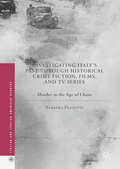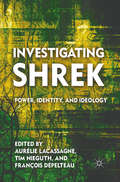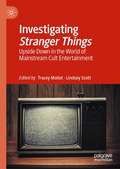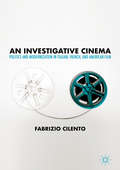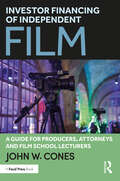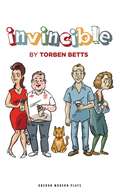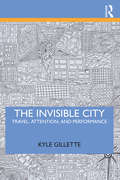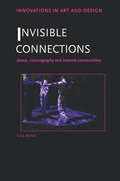- Table View
- List View
Introduction to Video Production: Studio, Field, and Beyond
by Ronald J. Compesi Jaime S. GomezWritten in a clear, non-technical manner, Introduction to Video Production focuses on the fundamental principles and aesthetics of video production and the technologies used in both studio and field environments. Ronald J. Compesi and Jaime S. Gomez cover each aspect of the process step by step, from preproduction to lighting, sound, directing, editing, graphics, and distribution. Taking into account the changes in workflow and production planning and distribution brought on by the advent of digital media, this second edition has been updated throughout to account for the increasing popularity of DSLR cameras, online distribution, the rise of portable cameras and mobile video, and much more. Key features include: a thorough overview of video production in studio and field environments without being overly technical, allowing students to get the "big picture" of production; coverage of new digital production, recording, and editing technologies; over 300 photos and line art illustrating aesthetic elements, technical issues, and production planning; key words identified in boldface throughout the text and reinforced in a comprehensive glossary of terms.
Introduction to Video Production: Studio, Field, and Beyond
by Ronald J. Compesi Jaime S. GomezWritten in a clear, non-technical manner, Introduction to Video Production focuses on the fundamental principles and aesthetics of video production and the technologies used in both studio and field environments. Ronald J. Compesi and Jaime S. Gomez cover each aspect of the process step by step, from preproduction to lighting, sound, directing, editing, graphics, and distribution. Taking into account the changes in workflow and production planning and distribution brought on by the advent of digital media, this second edition has been updated throughout to account for the increasing popularity of DSLR cameras, online distribution, the rise of portable cameras and mobile video, and much more. Key features include: a thorough overview of video production in studio and field environments without being overly technical, allowing students to get the "big picture" of production; coverage of new digital production, recording, and editing technologies; over 300 photos and line art illustrating aesthetic elements, technical issues, and production planning; key words identified in boldface throughout the text and reinforced in a comprehensive glossary of terms.
The Introspective Realist Crime Film
by Luis M. García-MainarThis book explores the formal and thematic conventions of crime film, the contexts in which these have flourished and their links with the social issues of a globalized world. The crime film has traditionally been identified with suspense, a heterogeneous aesthetic and a tacit social mind. However, a good number of the crime films produced since the early 2000s have shifted their focus from action or suspense and towards melodrama in narratives that highlight the social dimension of crime, intensify their realist aesthetics and dwell on subjectivity. With the 1940s wave of Hollywood semi-documentary crime films and 1970s generic revisionism as antecedents, these crime films find inspiration in Hollywood cinema and constitute a transnational trend. With a close look at Steven Soderbergh’s Traffic (2000), David Fincher’s Zodiac (2007), Jacques Audiard’s Un prophète (2009) and Tomas Alfredson’s Tinker Tailor Soldier Spy (2011), this book sets out the stylistic and thematic conventions, contexts and cultural significance of a new transnational trend in crime film.
The Introverted Actor: Practical Approaches
by Rob Roznowski Carolyn Conover Heidi KasevichDo you have to be an extrovert to succeed as an actor? This book offers ideas to create inclusive acting environments where the strengths of the introverted actor are as valued as those of their extroverted counterparts. As this book shows, many introverts are innately drawn to the field of acting, but can often feel inferior to their extroverted peers. From the classroom to professional auditions, from rehearsals to networking events, introverted actors tell their stories to help other actors better understand how to leverage their natural gifts, both onstage and off. In addition, The Introverted Actor helps to reimagine professional and pedagogical approaches for both actor educators and directors by offering actionable advice from seasoned psychology experts, professional actors, and award-winning educators.
Invasion of the Body Snatchers (BFI Film Classics)
by Barry Keith GrantUpon its release in 1956, Don Siegel's Invasion of the Body Snatchers was widely perceived as another 'B' movie thriller in the cycle of science fiction and horror films that proliferated in the 1950s. Yet the film addresses numerous issues brewing in post-war US society, including the Cold War, McCarthyism and the changing dynamics of gender relations. In the fifty years since the film's release, its reputation has grown from cult status to become an acknowledged classic of American cinema. With its narrative of emotionless alien duplicates replacing average folk, Invasion of the Body Snatchers was the first post-war horror film to locate the monstrous in the everyday, thus marking it as a pivotal moment in American horror film history four years before Psycho.In this first comprehensive critical study of the film, Barry Keith Grant traces Invasion's historical and generic contexts to explore the importance of Communism and conformity, post-war modernity and gender politics in order to understand the film's cultural significance and metaphorical weight. He also provides an account of the film's fraught production history and offers an extended discussion of the distinctive contributions of the production personnel. Concluding with a consideration of the three remakes it has inspired, Grant illustrates how Invasion of the Body Snatchers' enduring popularity derives from its central metaphor for the monstrous, which has proven as flexible as that of the vampire and the zombie.
The Invention of Europe in French Literature and Film
by E. OusselinOusselin sets out to show that Europe is essentially a literary fiction and that the ongoing movement towards European unity cannot be understood without reference to the literary works that helped bring it about.
The Invention of Martial Arts: Popular Culture Between Asia and America
by Paul BowmanThrough popular movies starring Bruce Lee and songs like the disco hit "Kung Fu Fighting," martial arts have found a central place in the Western cultural imagination. But what would 'martial arts' be without the explosion of media texts and images that brought it to a wide audience in the late 1960s and early 1970s? In this examination of the media history of what we now call martial arts, author Paul Bowman makes the bold case that the phenomenon of martial arts is chiefly an invention of media representations. Rather than passively taking up a preexisting history of martial arts practices--some of which, of course, predated the martial arts boom in popular culture--media images and narratives actively constructed martial arts. Grounded in a historical survey of the British media history of martial arts such as Bartitsu, jujutsu, judo, karate, tai chi, and MMA across a range of media, this book thoroughly recasts our understanding of the history of martial arts. By interweaving theories of key thinkers on historiography, such as Foucault and Hobsbawm, and Said's ideas on Orientalism with analyses of both mainstream and marginal media texts, Bowman arrives at the surprising insight that media representations created martial arts rather than the other way around. In this way, he not only deepens our understanding of martial arts but also demonstrates the productive power of media discourses.
INVENTION OF MARTIAL ARTS C: Popular Culture Between Asia and America
by Paul BowmanThrough popular movies starring Bruce Lee and songs like the disco hit "Kung Fu Fighting," martial arts have found a central place in the Western cultural imagination. But what would 'martial arts' be without the explosion of media texts and images that brought it to a wide audience in the late 1960s and early 1970s? In this examination of the media history of what we now call martial arts, author Paul Bowman makes the bold case that the phenomenon of martial arts is chiefly an invention of media representations. Rather than passively taking up a preexisting history of martial arts practices--some of which, of course, predated the martial arts boom in popular culture--media images and narratives actively constructed martial arts. Grounded in a historical survey of the British media history of martial arts such as Bartitsu, jujutsu, judo, karate, tai chi, and MMA across a range of media, this book thoroughly recasts our understanding of the history of martial arts. By interweaving theories of key thinkers on historiography, such as Foucault and Hobsbawm, and Said's ideas on Orientalism with analyses of both mainstream and marginal media texts, Bowman arrives at the surprising insight that media representations created martial arts rather than the other way around. In this way, he not only deepens our understanding of martial arts but also demonstrates the productive power of media discourses.
Investigating Italy's Past through Historical Crime Fiction, Films, and TV Series: Murder in the Age of Chaos (Italian and Italian American Studies)
by Barbara PezzottiThis book is the first monograph in English that comprehensively examines the ways in which Italian historical crime novels, TV series, and films have become a means to intervene in the social and political changes of the country. This study explores the ways in which fictional representations of the past mirror contemporaneous anxieties within Italian society in the work of writers such as Leonardo Sciascia, Andrea Camilleri, Carlo Lucarelli, Francesco Guccini, Loriano Macchiavelli, Marcello Fois, Maurizio De Giovanni, and Giancarlo De Cataldo; film directors such as Elio Petri, Pietro Germi, Michele Placido, and Damiano Damiani; and TV series such as the “Commissario De Luca” series, the “Commissario Nardone” series, and “Romanzo criminale–The series.” Providing the most wide-ranging examination of this sub-genre in Italy, Barbara Pezzotti places works set in the Risorgimento, WWII, and the Years of Lead in the larger social and political context of contemporary Italy.
Investigating Shrek: Power, Identity, and Ideology
by Aur�lie Lacassagne, Tim Nieguth, and Fran�ois D�pelteauAn exploration of the social significance of Shrek from a variety of theoretical perspectives, this book pursues two different, yet intertwined objectives. The first is to present Shrek as pedagogical tool that could be usefully employed in a number of different disciplines. Shrek is approached from a political science angle, a sociological perspective, and applied to the tenets of evolutionary psychology. The second objective is concerned with outlining some of the ways in which Shrek is actively bound up with various aspects of social reality - such as capitalism, power relations, inequality, rule and resistance. This book analyzes the green ogre and his companions in a way that is entertaining as well as informative.
Investigating Stranger Things: Upside Down in the World of Mainstream Cult Entertainment
by Tracey Mollet Lindsey ScottThis edited collection explores the narrative, genre, nostalgia and fandoms of the phenomenally successful Netflix original series, Stranger Things. The book brings together scholars in the fields of media, humanities, communications and cultural studies to consider the various ways in which the Duffer Brothers’ show both challenges and confirms pre-conceived notions of cult media. Through its three sections on texts, contexts and receptions, the collection examines all aspects of the series’ presence in popular culture, engaging in debates surrounding cult horror, teen drama, fan practices, and contemporary anxieties in the era of Trump. Its chapters seek to address relatively neglected areas of scholarship in the realm of cult media, such as set design, fashion, and the immersive Secret Cinema Experience. These discussions also serve to demonstrate how cult texts are facilitated by the new age of television, where notions of medium specificity are fundamentally transformed and streaming platforms open up shows to extensive analysis in the now mainstream world of cult entertainment.
An Investigative Cinema: Politics and Modernization in Italian, French, and American Film
by Fabrizio CilentoThis book traces the development of investigative cinema, whose main characteristic lies in reconstructing actual events, political crises, and conspiracies. These documentary-like films refrain from a simplistic reconstruction of historical events and are mainly concerned with what does not immediately appear on the surface of events. Consequently, they raise questions about the nature of the “truth” promoted by institutions, newspapers, and media reports. By highlighting unanswered questions, they leave us with a lack of clarity, and the questioning of documentation becomes the actual narrative. Investigative cinema is examined in relation to the historical conjunctures of the “economic miracle” in Italy, the simultaneous decolonization and reordering of culture in France, the waves of globalization and neoliberalism in post-dictatorial Latin America, and the post-Watergate, post-9/11 climate in US society. Investigative cinema is exemplified by the films Salvatore Giuliano, The Battle of Algiers, The Parallax View, Gomorrah, Zero Dark Thirty, and Citizenfour.
An Investigative Cinema: Politics and Modernization in Italian, French, and American Film
by Fabrizio CilentoThis book traces the development of investigative cinema, whose main characteristic lies in reconstructing actual events, political crises, and conspiracies. These documentary-like films refrain from a simplistic reconstruction of historical events and are mainly concerned with what does not immediately appear on the surface of events. Consequently, they raise questions about the nature of the “truth” promoted by institutions, newspapers, and media reports. By highlighting unanswered questions, they leave us with a lack of clarity, and the questioning of documentation becomes the actual narrative. Investigative cinema is examined in relation to the historical conjunctures of the “economic miracle” in Italy, the simultaneous decolonization and reordering of culture in France, the waves of globalization and neoliberalism in post-dictatorial Latin America, and the post-Watergate, post-9/11 climate in US society. Investigative cinema is exemplified by the films Salvatore Giuliano, The Battle of Algiers, The Parallax View, Gomorrah, Zero Dark Thirty, and Citizenfour.
Investing in Movies: Strategies for Investors and Producers
by Joseph N. CohenInvesting in Movies: Strategies for Investors and Producers is a useful guide for investors and producers looking for an analytical framework to assess the opportunities and pitfalls of film investments. The book traces macroeconomic trends and the globalization of the business, as well as the impact these have on potential returns. It offers a broad range of guidelines on how to source interesting projects and advice on what kinds of projects to avoid, as well as numerous ways to maximize risk-adjusted returns. While focusing primarily on investments in independent films, industry veteran and author Joseph Cohen also provides valuable insights into the studio and independent slate deals that have been marketed to the institutional investment community. Features of this book include: A guide to the minefield of film investing for the potential investor, giving students and aspiring professionals an insider perspective; A detailed explanation of the risk and rewards inherent in the film business and how to evaluate projects; Thorough coverage of the cast of characters that populate the film space, and advice on building relationships to optimize opportunities.
Investing in Movies: Strategies for Investors and Producers
by Joseph N. CohenInvesting in Movies: Strategies for Investors and Producers is a useful guide for investors and producers looking for an analytical framework to assess the opportunities and pitfalls of film investments. The book traces macroeconomic trends and the globalization of the business, as well as the impact these have on potential returns. It offers a broad range of guidelines on how to source interesting projects and advice on what kinds of projects to avoid, as well as numerous ways to maximize risk-adjusted returns. While focusing primarily on investments in independent films, industry veteran and author Joseph Cohen also provides valuable insights into the studio and independent slate deals that have been marketed to the institutional investment community. Features of this book include: A guide to the minefield of film investing for the potential investor, giving students and aspiring professionals an insider perspective; A detailed explanation of the risk and rewards inherent in the film business and how to evaluate projects; Thorough coverage of the cast of characters that populate the film space, and advice on building relationships to optimize opportunities.
Investing in Movies: Strategies for Investors and Producers (American Film Market Presents)
by Joseph N. CohenIn this second edition of Investing in Movies, industry veteran Joseph N. Cohen provides investors and producers with an analytical framework to assess the opportunities and pitfalls of film investments. The book traces macroeconomic trends and the globalization of the business, including the rise of streamers, as well as the impact these have on potential returns. It offers a broad range of guidelines on how to source interesting projects and advice on what kinds of projects to avoid, as well as numerous ways to maximize risk-adjusted returns. While focusing primarily on investments in independent films, Cohen also provides valuable insights into the studio and independent slate deals that have been marketed to the institutional investment community. As well, this new edition has been updated to fully optimize the current film industry climate including brand new chapters on the Chinese film market, new media/streaming services, and the effects of COVID-19 on the global film market. Written in a detailed and approachable manner, this book is essential for students and aspiring professionals looking to gain an insider perspective against the minefield of film investing.
Investing in Movies: Strategies for Investors and Producers (American Film Market Presents)
by Joseph N. CohenIn this second edition of Investing in Movies, industry veteran Joseph N. Cohen provides investors and producers with an analytical framework to assess the opportunities and pitfalls of film investments. The book traces macroeconomic trends and the globalization of the business, including the rise of streamers, as well as the impact these have on potential returns. It offers a broad range of guidelines on how to source interesting projects and advice on what kinds of projects to avoid, as well as numerous ways to maximize risk-adjusted returns. While focusing primarily on investments in independent films, Cohen also provides valuable insights into the studio and independent slate deals that have been marketed to the institutional investment community. As well, this new edition has been updated to fully optimize the current film industry climate including brand new chapters on the Chinese film market, new media/streaming services, and the effects of COVID-19 on the global film market. Written in a detailed and approachable manner, this book is essential for students and aspiring professionals looking to gain an insider perspective against the minefield of film investing.
Investor Financing of Independent Film: A Guide for Producers, Attorneys and Film School Lecturers
by John W. ConesThis book explains how to comply with the federal and states securities regulations when seeking to raise money from private investors for the development, production and/or distribution of a feature or documentary film. Drawing from the experience and expertise of a securities and entertainment attorney who has worked with independent filmmakers for 30 plus years, this resource explores securities law compliance in order to help readers comply with the law and avoid criminal and civil liability, while successfully raising investor funds for their film projects. Readers will gain an understanding of why the securities laws apply to most investor financing transactions, what choices need to be made by the filmmaker, what information needs to be disclosed to prospective investors, how to comply with the SEC’s policy regarding financial projections, what is the appropriate investment vehicle for various forms of investor financing, what limitations are imposed on the use of finders and how to handle the required federal and state notice filings. It is an essential resource for any film student taking a film finance course (or a production course with a film finance component), as well as any independent film producers, entertainment/securities attorneys and film school instructors, who want to be informed about the legal and practical aspects of investor financing of independent films.
Investor Financing of Independent Film: A Guide for Producers, Attorneys and Film School Lecturers
by John W. ConesThis book explains how to comply with the federal and states securities regulations when seeking to raise money from private investors for the development, production and/or distribution of a feature or documentary film. Drawing from the experience and expertise of a securities and entertainment attorney who has worked with independent filmmakers for 30 plus years, this resource explores securities law compliance in order to help readers comply with the law and avoid criminal and civil liability, while successfully raising investor funds for their film projects. Readers will gain an understanding of why the securities laws apply to most investor financing transactions, what choices need to be made by the filmmaker, what information needs to be disclosed to prospective investors, how to comply with the SEC’s policy regarding financial projections, what is the appropriate investment vehicle for various forms of investor financing, what limitations are imposed on the use of finders and how to handle the required federal and state notice filings. It is an essential resource for any film student taking a film finance course (or a production course with a film finance component), as well as any independent film producers, entertainment/securities attorneys and film school instructors, who want to be informed about the legal and practical aspects of investor financing of independent films.
Invincible (Oberon Modern Plays Ser.)
by Torben BettsThe recession is biting hard so Emily and Oliver have decided to downsize and shift their middle-class London lifestyle to a small town in the north of England. They want to live, work and raise their two young children in a friendly community, among what Emily terms ‘real people’, away from the cold anonymity of the city. These left-leaning, well-educated people have invited over two of their new neighbours in an attempt to break the ice. Tonight Alan and Dawn will be offered olives and anchovies and are introduced to Karl Marx and abstract art. As classes and outlooks collide, the scene is set for a rendezvous with consequences as hilarious as they are tragic.
The Invisible Actor (Bloomsbury Revelations)
by Yoshi Oida Lorna MarshallThe Invisible Actor presents the captivating and unique methods of the distinguished Japanese actor and director, Yoshi Oida. While a member of Peter Brook's theatre company in Paris, Yoshi Oida developed a masterful approach to acting that combined the oriental tradition of supreme and studied control with the Western performer's need to characterise and expose depths of emotion. Written with Lorna Marshall, Yoshi Oida explains that once the audience becomes openly aware of the actor's method and becomes too conscious of the actor's artistry, the wonder of performance dies. The audience must never see the actor but only his or her performance. Throughout Lorna Marshall provides contextual commentary on Yoshi Oida's work and methods. In a new foreword to accompany the Bloomsbury Revelations edition, Yoshi Oida revisits the questions that have informed his career as an actor and explores how his skilful approach to acting has shaped the wider contours of his life.
The Invisible Actor (Bloomsbury Revelations)
by Yoshi Oida Lorna MarshallThe Invisible Actor presents the captivating and unique methods of the distinguished Japanese actor and director, Yoshi Oida. While a member of Peter Brook's theatre company in Paris, Yoshi Oida developed a masterful approach to acting that combined the oriental tradition of supreme and studied control with the Western performer's need to characterise and expose depths of emotion. Written with Lorna Marshall, Yoshi Oida explains that once the audience becomes openly aware of the actor's method and becomes too conscious of the actor's artistry, the wonder of performance dies. The audience must never see the actor but only his or her performance. Throughout Lorna Marshall provides contextual commentary on Yoshi Oida's work and methods. In a new foreword to accompany the Bloomsbury Revelations edition, Yoshi Oida revisits the questions that have informed his career as an actor and explores how his skilful approach to acting has shaped the wider contours of his life.
The Invisible City: Travel, Attention, and Performance
by Kyle GilletteThe Invisible City explores urban spaces from the perspective of a traveller, writer, and creator of theatre to illuminate how cities offer travellers and residents theatrical visions while also remaining mostly invisible, beyond the limits of attention. The book explores the city as both stage and content in three parts. Firstly, it follows in pattern Italo Calvino's novel Invisible Cities, wherein Marco Polo describes cities to the Mongol emperor Kublai Khan, to produce a constellation of vignettes recalling individual cities through travel writing and engagement with artworks. Secondly, Gillette traces the Teatro Potlach group and its ongoing immersive, site-specific performance project Invisible Cities, which has staged performances in dozens of cities across Europe and the Americas. The final part of the book offers useful exercises for artists and travellers interested in researching their own invisible cities. Written for practitioners, travellers, students, and thinkers interested in the city as site and source of performance, The Invisible City mixes travelogue with criticism and cleverly combines philosophical meditations with theatrical pedagogy.
The Invisible City: Travel, Attention, and Performance
by Kyle GilletteThe Invisible City explores urban spaces from the perspective of a traveller, writer, and creator of theatre to illuminate how cities offer travellers and residents theatrical visions while also remaining mostly invisible, beyond the limits of attention. The book explores the city as both stage and content in three parts. Firstly, it follows in pattern Italo Calvino's novel Invisible Cities, wherein Marco Polo describes cities to the Mongol emperor Kublai Khan, to produce a constellation of vignettes recalling individual cities through travel writing and engagement with artworks. Secondly, Gillette traces the Teatro Potlach group and its ongoing immersive, site-specific performance project Invisible Cities, which has staged performances in dozens of cities across Europe and the Americas. The final part of the book offers useful exercises for artists and travellers interested in researching their own invisible cities. Written for practitioners, travellers, students, and thinkers interested in the city as site and source of performance, The Invisible City mixes travelogue with criticism and cleverly combines philosophical meditations with theatrical pedagogy.
Invisible Connections: Dance, Choreography and Internet Communities
by Sita PopatThe first and only book to focus on dance on the Internet, Sita Popat‘s fascinating Invisible Connections examines how Internet and communication technologies offer dance and theatre new platforms for creating and performing work, and how opportunities for remote interaction and collaboration are available on a scale never before imaginable.Drawing






